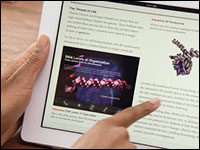
Part 1 of this three-part series discusses the “positive feedback loop” tying the evolution of mobile device technologies to the evolution of cloud computing.
For decades, U.S. cell carriers have crippled the American mobile ecosystem. Their nickel-and-dime mentality has hobbled user and device manufacturer alike. RIM’s BlackBerry nearly didn’t get off the ground simply because carriers couldn’t see a need to push email nor a way to squeeze more money out of users for the service.
Ditto every mobile innovation from ringtones and wallpapers to mobile browsers and SMS (texting). Mobile broadband speeds are at a near-crawl in the U.S., compared to other countries, and carriers have spent too little, too late to even make a pretense at modernizing their infrastructure to keep pace.
Indeed, carriers were slow to every mobile party — not in a fashionably late sort of a way, but in a kicking-and-scheming, show-me-the-money apoplectic shuffle.
In a futile effort to maintain control, U.S. carriers routinely bullied device manufacturers and disabled features — offering users dried-out skeletons of once-meaty functionalities. And they charged their customers five-star restaurant prices for this pittance of a drive-through meal.
At long last, the tables have turned.
Consumer Uprising
“AT&T, Sprint, and Verizon are essentially being held hostage by the cellphone manufacturers,” Brian Flynn, vice president of operations at Xtel Comunications, told TechNewsWorld. “When you consider how the cellphone industry started out, this has been a pretty remarkable paradigm shift.”
Mostly it was the advent of the iPhone, iPad and Droid that strong-armed the change. Mostly, but not totally. Even Steve Jobs has yet to entirely shed carrier chains.
User rebellion is certainly a factor in this shift. Consumer demand for Web-heavy devices and a never-ending supply of mobile apps is pushing carriers beyond their antiquated capabilities. Meanwhile, users are accepting no excuses and taking no prisoners.
For example, AT&T, once a monopoly in control of all phones in every household and business, now finds itself on the flop end of a carrier vs. customer flip-flop.
“AT&T’s short-lived policies to not support some of the iPhone’s more bandwidth-heavy applications have been met with outrage from iPhone user groups,” said Flynn.
The question now is whether the cloud may be the weapon consumers needed to finally and forever break the carriers’ stranglehold.
“If the carrier’s network doesn’t support the full capabilities of the phone, the consumer is smart enough to know that it’s the carrier’s fault, and this ultimately forces the carrier’s hand to support all cloud-based applications,” explained Flynn.
Carrier Winds Hold Cloud at Bay
Despite growing user discontent, the cloud will not change carrier behavior any time soon.
“The migration to mobile cloud applications will not immediately liberate device manufacturers from the restrictions imposed by some U.S. wireless carriers,” Michael Demler, senior strategic analyst at Digdia, told TechNewsWorld.
“All the potential restrictions will still be in place, such as prohibiting installation of out-of-market apps,” he said. “Wireless operators will continue to preload their preferred browsers, search engines and app stores.”
However, carrier power will continue unabated and undiluted in the near term, mostly because of one simple thing: coverage.
“Right now, carrier connections are far more prevalent than WiFi or WiMax,” Aaron Maxwell, founder of MobileWeb Up, told TechNewsWorld. “Because of connectivity issues, rising demand for mobile cloud services may actually increase demand for carrier data services.”
“Someday, it’s likely we’ll see large areas being blanketed with non-carrier WiFi or WiMax,” he said, “but it will be years or longer before it can even match current carrier coverage, much less surpass it.”
Cloud Storms the Carrier Hold
That is not to say, however, that carriers enjoy their former iron grip. Their fist, though still closed tightly, is slipping.
“Consumers, both in the enterprise and among the general population, will never again tolerate a smartphone with no Web browser, or a crippled one,” said Maxwell. “As mobile browsers continue to improve — notice the steady innovation of Mobile WebKit-based browsers — mobile Web applications will be able to do more of those things that previously required carrier cooperation… whether the carriers like it or not.”
Carriers have also lost many of their legal footholds. The Library of Congress declared jailbreaking phones and other mobile devices legal in July. Without the ability to enforce and police copyright infringement claims or to void warranties and the like for modifying a device, consumers are free to go app crazy.
This is distressing to carriers (and some device manufacturers) as it effectively dams their revenue stream from app stores. Of course, jailbreaking opens users to considerable risk as well, ranging from bricking the device to loading a slew of malware.
However, it also opens the gates to the full force of the cloud.
Once a smartphone accesses an app, the app can function undeterred and the carrier loses its grip entirely. But don’t expect carriers to give up easily.
“The maturation of HTML5 will enable the development of more powerful cloud-based apps, but the user interface to select and interact with those apps will be embedded within the device,” explained Digdia’s Demler.
Anything embedded in the device is usually subject to carrier control. Device manufacturers have tried to slip past this obstacle before and failed.
“The bottom line is that a device that doesn’t have the carrier’s approval is not going to be provided the channel support required to sell well,” Jonathan Shaw, Ph.D., principal at Pace Harmon.
For example, Google attempted to sell its Nexus One handsets direct to the consumer, he told TechNewsWorld, an effort that is widely viewed as a failure.
“Therefore, manufacturers still need to accommodate the carriers’ demands to ensure their devices will be sold via the carriers’ shops and website,” he said.
Winner Takes All
In order for the cloud to prevail, carrier control must crumble or be abdicated.
“To fully enable cloud services as an alternative to carriers’ current core offerings requires open access to the networks and the handsets,” said Shaw. For example, deploying cloud VoIP (such as Skype or Google Voice) requires that the carrier be prevented from blocking or throttling the service across its network.
“To enable full usability — and drive customer acceptance and use — it is also preferable for the cloud service provider to be able to deploy a custom application on the handset,” he explained, “rather than limiting the functionality to that available in a mobile browser.”
So is this likely to happen? Shaw made three predictions for the probable outcome:
Neutral Networks Anticipated. Whether driven by Net neutrality regulations or consumer preference, he said, expect the end-state to be neutral networks — i.e., carriers will become “dumb pipes.” This shift will cause them to change how they charge for their services. Current rollouts of usuage-based wireless data plans are just the beginning of the changes to come.
Mobile Operating Systems Will Die. Expect further consolidation of the mobile OS market — few developers can afford to create five to 10 different versions of applications — “and the less popular OSes will gradually die off.” However, the number and power of apps will greatly increase when there are only one or two OSes to work with and the cloud negates the need for carrier approvals.
An Open OS Will Have a Deciding Edge. If the network is open, a mobile browser can support cloud offerings, but the functionality in a browser-based application is limited. Having an open OS, such that applications and UIs can be developed, will likely be necessary from a Cloud application usability perspective.





















































